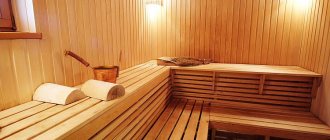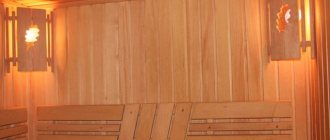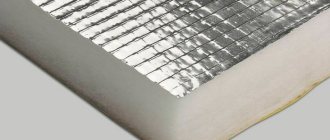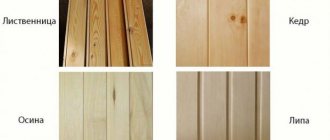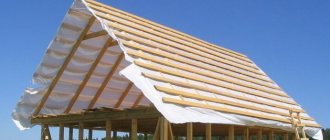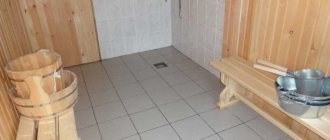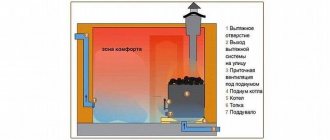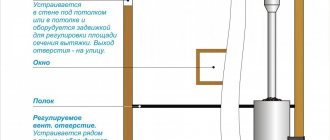General characteristics
Water-borne protective composition based on acrylate.
Protective antibacterial impregnation for wood in a water-based bath Tikkurila Supi Saunasuoja (Tikkurila Supi Saunasuoya)
Application area
Protective composition for surfaces in damp rooms, forming a dirt- and water-repellent surface. Contains anti-blue stain and anti-mold components. Used for coating wooden, wood fiber and concrete surfaces, according to the instructions for use. Do not use baths for treating shelves. It is used, in particular, for treating walls and ceilings in the steam room, washroom and dressing room of the bathhouse.
| Consumption | 8-12 m²/l. |
| Dry residue | Approx 16%. |
| Density | 1.0 kg/l. |
| Diluent | Water. |
| Application method | Apply by brush or spray. |
| Shine | Semi-matte. |
| Storage | Protect from frost. |
| Tara | 0.9 l, 2.7 l, 9 l. |
Drying time at +23ºС and relative humidity 50% – 30 minutes. The next layer can be applied after 2 - 3 hours. The surface is ready for use in about two days.
If necessary, the protective composition is tinted in one of the colors of the Tikkuril palette (pictured below).
The color catalog “Tintable varnishes for interiors” includes 30 glaze colors. The final color is influenced by the color and porosity of the wood itself, as well as the number of layers and gloss of the varnish. It is recommended to carry out a test painting
Prices are approximately like this:
- 2.7 l packaging - about $25;
- packaging 9 l — — about $74.
Technical data
| Colors | Colorless. Deepens the color of the wood. |
| Gloss level | not defined |
| Consumption | 8-15 m/l depending on the porosity of the wood. |
| Tara | 250 ml, 1 l. |
| Price | 250 ml - $8-10; 1 l – 15.5 – 18 $ |
| Application method | Apply with a brush or clean cloth. |
| Drying time, +23 °C at rel. humid air 50% | Ready for use after the oil has soaked into the wood. The rate of absorption depends on the porosity of the wood. Wipe off excess oil. |
| Dry residue | 100%. |
| Density | 0.8 kg/l. |
| Storage | Protect from frost. |
Instructions for use
Conditions for painting
The surface to be painted must be dry. The air temperature should be above +5ºС, and the relative humidity less than 80%.
Preliminary preparation
Clean the surface from dirt and dust. If necessary, sand rough wooden surfaces before coating. Remove sanding dust.
Treatment
Mix the composition thoroughly before use, as well as during work, in order to ensure uniform mixing of the pigment concentrate and the matting component in it. If necessary, dilute with water. Apply the composition in 2 layers in the direction of the wood grain, and in steam rooms only in one layer.
When applying a tinted composition to check the shade, it is recommended to do a test coloring on a separate board. The final color of the coating depends on the nature, hardness and original color of the wood, as well as the number of layers. To avoid differences in shade, the entire surface should always be treated continuously, and when processing large panel surfaces, several boards at a time.
Cleaning Tools
Wash working tools with water or Pensselipesa detergent.
Care
Not earlier than a month after treatment. Clean the surface with Soupi Saunapesu (0.1-0.5 liters of product per 5 liters of water). To remove lime salts, use a 10-15% solution. To remove thick layers of lime salts and rust, use undiluted Soupi Saunapes. To whiten shelves, use “Soupi Saunapes” diluted in water (1 part product - 1 part water). Let it act for 15 minutes. and rinse with clean water.
Required Tool
In order to efficiently process the internal surfaces of the sauna (lining), we will need a certain set of tools for painting work:
- Paint and varnish compositions for application to surfaces;
- Solvent;
- Personal protective equipment – goggles, respirator, rubber gloves;
- Spray gun, roller, brush;
- Paint tray.
The selection of protective compounds is based on available means and personal preferences, but it must be said that you should not save on such materials, because they extend the life of the wood and protect it from an aggressive environment.
Imported impregnation Tikkuril
Application time
Work on applying impregnation is carried out in two approaches. The first is performed before installing the lining. It is very important to process not only the cladding, but also the sheathing on which it is attached.
The final stage occurs after finishing the walls. Experts recommend that if the bath is used at a high intensity, such work should be carried out at least twice a year.
Important. If you first properly treat the wooden surface with an antiseptic, you can save a lot on paint and varnish materials in the future.
Selection of compositions for processing
In order for the work done by yourself to be of high quality, you need to take a responsible approach to the choice of materials and understand them.
Today, the choice of such compositions in construction stores is quite large, and you can purchase both products from world-famous manufacturers, for example Tikkuril, and our domestic ones.
But not everything that is offered to us in the store is suitable, because the sauna has increased temperature and humidity.
Therefore, to select, you need special knowledge about each of the protective compounds; let’s look at each in more detail:
- Drying oil. It can be used for both external and internal work, but, unfortunately, it almost does not protect the wood from the effects of water vapor;
- Acrylic lacquer. Helps maintain natural color and protects the material from ultraviolet exposure. However, when such a composition is exposed to high temperature, it emits an unpleasant odor;
- Varnish with solvent. This is a pretty good antiseptic, the price of which is low. Unfortunately, due to the fact that when heated, such varnish releases toxins and has a pungent odor, it cannot be used inside saunas;
- Special impregnation. These materials are created specifically for baths; they are not afraid of high temperatures and humidity, and do not emit unpleasant odors and toxins. When working with them, you don’t need any special skills or knowledge, so you can even apply them yourself.
As you can see, the list of compositions is large, but not every one of this list can be used for interior work in a sauna.
Domestic varnish for saunas “Aqua”
We carry out surface treatment
In order to complete this work, you will need instructions that will help you better navigate during its implementation:
- First you need to clean the surface from dust. To do this easily and quickly, take warm water and add soda to it. The approximate proportion is 300 grams of soda per 10 liters of water;
- Next, degrease the surface;
- To get a smooth surface, it is better to sand the lining itself; this work can be done using pumice;
- Then we apply an antiseptic agent to the surface of the lining that protects against fungus;
- Now you can proceed directly to the impregnation stage;
- After the impregnation has dried, special paint should be applied over it.
Advice. If you apply paint with a brush, then the last layer must be applied with movements that are parallel to the direction of the fibers on the material. In this case, the brush mark from application will be invisible.
Basic recommendations from experts
- Before application, the paint must be thoroughly mixed, this will promote uniform drying and color of the surface;
- Before you start applying, it is best to make sure that you have chosen the right color and the desired thickness. To do this, we do a test opening from the edge;
- To achieve the best painting effect, you need to apply the coloring composition in a thin layer;
- It is better to paint metal elements with a special sponge;
- The primer is tinted to match the color of the coating itself;
- Work cannot be performed in hot weather.
Important. When painting with your own hands, you need to pay special attention to the ends of the lining, because these are its most vulnerable places.
Selection rules
When choosing an antiseptic for wood treatment, it is necessary to take into account a fairly large list of criteria.
- Cost of antiseptic. It is not recommended to buy a cheap one, because the protective material must perform several tasks at once, and a good, expensive option can do this.
- Where are protective measures carried out? That is, outside or inside the bathhouse. Therefore, carefully study what is written on the label.
- Compound. The best option is if it is a combined option, because it can be used to both protect against pests and increase the fire-retardant properties of wood.
- Manufacturer. Let's face it, it's an important factor. As always, it is better to give your preference to well-known brands. For example, the Finnish manufacturer of paints and varnishes Tikkurila or the domestic brand Senezh or Neomid.
- Safety. Everything is clear here. Many experts recommend using water-based antiseptics for internal treatment of baths. When purchasing, be sure to ask for a quality certificate and a Sanitary and Epidemiological Expertise conclusion.
When deciding which antiseptic to choose for a bath, you need to take into account the amount of material used. This depends on the absorption of the material into the wood. The thing is that the antiseptic solution itself can be absorbed in small quantities, or the consumption may increase to the maximum. This primarily depends on the wood being processed. Eg:
- Pine easily absorbs antiseptic, so its processing will require more protective material.
- Linden, cedar, alder, aspen - have an average absorbency value.
- Oak, larch, birch, fir, ash have a high density, so the antiseptic is absorbed into them with great difficulty.
So, taking into account all the above criteria, you can make the right choice of antiseptic for the bath. Now let's look at the main manufacturers.
Sheathing care
- The most important component of care is timely ventilation;
- You can wash such a surface with a damp cloth, but without using household chemicals;
- If severe contamination occurs, it should be removed only after the boards have completely dried. In this case, we clean the surface with sandpaper;
- In household chemical stores you can purchase special sauna care products that remove dirt without damaging the surface.
Photo of the treated steam room
Features of oil treatment
- If pure oil (usually linseed) is used, it is heated to 50-60 degrees before processing.
- The composition is applied either with a brush with natural bristles or with a cotton cloth.
- Apply the oil in a thin, even layer.
- The product is applied 5-6 times with layered sanding.
- After covering the next layer, wait for it to dry, then sand and apply the next one.
- It takes at least 2-3 weeks for a surface coated with linseed oil to completely dry.
If a mixture of oil and wax is used to process the bath, then the ingredients are taken in a 2:1 ratio to make it. To prepare the product, add heated wax to hot oil and then mix well.
The mixture is applied with a foam sponge strictly along the fibers. When the first layer has dried, remove the residue with a waffle cloth and treat the surface again.
